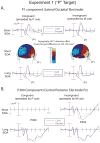Magnocellular and parvocellular influences on reflexive attention
- PMID: 21723311
- PMCID: PMC3152614
- DOI: 10.1016/j.visres.2011.06.012
Magnocellular and parvocellular influences on reflexive attention
Abstract
Previous studies have provided conflicting evidence regarding whether the magnocellular (M) or parvocellular (P) visual pathway is primarily responsible for triggering involuntary orienting. Here, we used event-related potentials (ERPs) to provide new evidence that both the M and P pathways can trigger attentional capture and bias visual processing at multiple levels. Specifically, cued-location targets elicited enhanced activity, relative to uncued-location targets, at both early sensory processing levels (indexed by the P1 component) and later higher-order processing stages (as indexed by the P300 component). Furthermore, the present results show these effects of attentional capture were not contingent on the feature congruency between the cue and expected target, providing evidence that this biasing of visual processing was not dependant on top-down expectations or within-pathway priming.
Copyright © 2011 Elsevier Ltd. All rights reserved.
Figures



Similar articles
-
The role of top-down spatial attention in contingent attentional capture.Psychophysiology. 2016 May;53(5):650-62. doi: 10.1111/psyp.12615. Epub 2016 Feb 16. Psychophysiology. 2016. PMID: 26879628
-
Effect of temporal predictability on exogenous attentional modulation of feedforward processing in the striate cortex.Int J Psychophysiol. 2016 Jul;105:9-16. doi: 10.1016/j.ijpsycho.2016.04.007. Epub 2016 Apr 22. Int J Psychophysiol. 2016. PMID: 27114044
-
Attention and sensory gain control: a peripheral visual process?J Cogn Neurosci. 2005 Dec;17(12):1936-49. doi: 10.1162/089892905775008715. J Cogn Neurosci. 2005. PMID: 16356330 Clinical Trial.
-
Neural mechanisms of visual selective attention.Psychophysiology. 1995 Jan;32(1):4-18. doi: 10.1111/j.1469-8986.1995.tb03400.x. Psychophysiology. 1995. PMID: 7878167 Review.
-
Visual streams and shifting attention.Prog Brain Res. 2009;176:47-63. doi: 10.1016/S0079-6123(09)17604-5. Prog Brain Res. 2009. PMID: 19733749 Review.
Cited by
-
Making the Thermodynamic Cost of Active Inference Explicit.Entropy (Basel). 2024 Jul 24;26(8):622. doi: 10.3390/e26080622. Entropy (Basel). 2024. PMID: 39202092 Free PMC article.
-
Visual mismatch negativity in the dorsal stream is independent of concurrent visual task difficulty.Front Hum Neurosci. 2013 Jul 30;7:411. doi: 10.3389/fnhum.2013.00411. eCollection 2013. Front Hum Neurosci. 2013. PMID: 23908621 Free PMC article.
-
Fixation-related potentials during a virtual navigation task: The influence of image statistics on early cortical processing.Atten Percept Psychophys. 2025 Jan;87(1):261-283. doi: 10.3758/s13414-024-03002-5. Epub 2025 Jan 23. Atten Percept Psychophys. 2025. PMID: 39849263 Free PMC article.
-
Tracking Visual Events in Time in the Absence of Time Perception: Implicit Processing at the ms Level.PLoS One. 2015 Jun 1;10(6):e0127106. doi: 10.1371/journal.pone.0127106. eCollection 2015. PLoS One. 2015. PMID: 26030155 Free PMC article. Clinical Trial.
References
-
- Abrams RA, Christ SE. Motion onset captures attention. Psychological Science. 2003;14:427–432. - PubMed
-
- Atchley P, Kramer AF, Hillstrom AP. Contingent capture for onsets and offsets: Attentional set for perceptual transients. Journal of Experimental Psychology: Human Perception & Performance. 2000;26:594–606. - PubMed
-
- Boynton RM, Kaiser PK. Vision: the additivity law made to work for heterochromatic photometry with bipartite fields. Science. 1968;161:366–368. - PubMed
-
- Chatrian GE, Lettich E, Nelson PL. Ten percent electrode system for topographic studies of spontaneous and evoked EEG activity. American Journal of EEG technology. 1985;25:83–92.
Publication types
MeSH terms
Grants and funding
LinkOut - more resources
Full Text Sources
Miscellaneous

